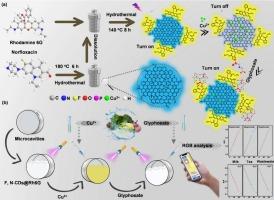基于罗丹明6g功能化碳点的便携式智能手机集成微腔传感器用于比例测定Cu2+和草甘膦
IF 4.9
2区 化学
Q1 CHEMISTRY, ANALYTICAL
引用次数: 0
摘要
由于有害离子和农药残留对环境过程的有害和无处不在的影响,它们的持久性日益增加一直是一个令人关注的问题。在此,我们设计了一个比例荧光平台,用于级联识别Cu2+和草甘膦,该平台通过将罗丹明6G接枝到F, n掺杂的碳点上(F, N-CDs@Rh6G)而设计。F, N-CDs@Rh6G/Cu2+螯合络合物的形成在438 nm处引起荧光猝灭,这归因于静态络合物的形成和光致能量转移。随后,草甘膦的引入逆转了螯合物的结合优先级,导致荧光信号在438 nm处恢复,而参比峰(558 nm)保持相对稳定。在最佳条件下,荧光探针对Cu2+ (61 nM)和草甘膦(53 nM)具有较低的检出限(lod)。此外,设计了一种结合智能手机的便携式微腔传感平台,用于可视化和现场定量Cu2+和草甘膦,具有特殊的lod。因此,这个新的F, N-CDs@Rh6G微腔为Cu2+和草甘膦的测定提供了一个可靠的级联传感平台,展示了潜在的应用前景。本文章由计算机程序翻译,如有差异,请以英文原文为准。

A portable smartphone-integrated microcavity sensor based on rhodamine 6G-functionalized carbon dots for ratiometric determination of Cu2+ and glyphosate
The increasing persistence of harmful ions and pesticide residues has been a matter of concern due to their pernicious and ubiquitous impact on environmental processes. Herein, we design a ratiometric fluorescent platform for the cascade identification of Cu2+ and glyphosate, which is devised by grafting rhodamine 6G onto F, N-doped carbon dots (F, N-CDs@Rh6G). The formation of F, N-CDs@Rh6G/Cu2+ chelation complex induces fluorescence quenching at 438 nm, attributed to static complex formation and photoinduced energy transfer. Subsequently, the introduction of glyphosate reverses the binding priority of the chelated complex and results in the recovery of fluorescence signal at 438 nm, while the reference peak (558 nm) remains relatively stable. Under optimal conditions, the fluorescent probe exhibits the low detection limits (LODs) for Cu2+ (61 nM) and glyphosate (53 nM). Additionally, a portable microcavity sensing platform combining with smartphone is devised for visual and on-site quantification of Cu2+ and glyphosate with the exceptional LODs. Therefore, this newly microcavity with F, N-CDs@Rh6G provides a reliable cascade sensing platform for Cu2+ and glyphosate determination, showcasing potential applications.
求助全文
通过发布文献求助,成功后即可免费获取论文全文。
去求助
来源期刊

Microchemical Journal
化学-分析化学
CiteScore
8.70
自引率
8.30%
发文量
1131
审稿时长
1.9 months
期刊介绍:
The Microchemical Journal is a peer reviewed journal devoted to all aspects and phases of analytical chemistry and chemical analysis. The Microchemical Journal publishes articles which are at the forefront of modern analytical chemistry and cover innovations in the techniques to the finest possible limits. This includes fundamental aspects, instrumentation, new developments, innovative and novel methods and applications including environmental and clinical field.
Traditional classical analytical methods such as spectrophotometry and titrimetry as well as established instrumentation methods such as flame and graphite furnace atomic absorption spectrometry, gas chromatography, and modified glassy or carbon electrode electrochemical methods will be considered, provided they show significant improvements and novelty compared to the established methods.
 求助内容:
求助内容: 应助结果提醒方式:
应助结果提醒方式:


